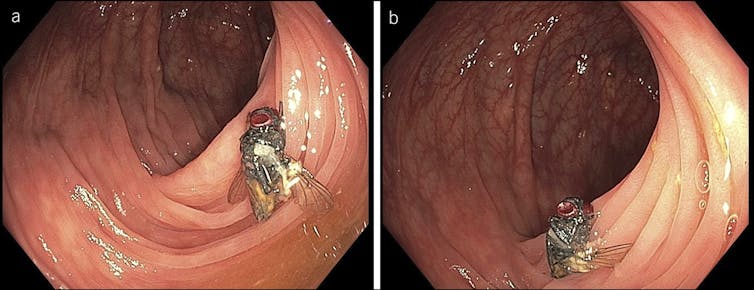
Doctors in Missouri recently made a startling discovery. A 63-year-old patient who went for a routine colon screening was found to have an intact fly in his colon. The doctors had no idea how the fly survived the perilous journey through the patient’s digestive enzymes and stomach acid.
As a professor of anatomy, I come across many such stories of strange things found inside people – foreign bodies, we call them. Here is a roundup of some of them.
A lady in Taiwan recently made the news because a spider and its exoskeleton were found inside her ear. Spiders inside the body are fairly rare, and those with arachnophobia will be pleased to hear that, despite what some say, we don’t eat eight spiders a year in our sleep.
However, one unfortunate British postman had an unpleasant result of swallowing a spider, which bit him causing his throat to swell and impair breathing.
While the person giving a home to a spider had little choice in the matter, other people often find themselves ingesting or inhaling things they didn’t mean to. The vast majority of these people are children, particularly when learning to wean.
Sadly, the location of these objects in the respiratory tract is one of the most common causes of death in children under three years of age.
Children tend to place things in their mouths, noses and ears. Things in the mouth and nose typically get inhaled and lodge in the respiratory tract, usually causing choking, which expels the object.
The things children are likely to inhale range from the familiar (toys, beads, magnets) to the unexpected (leeches and needles). And inhaled items vary by region. In western countries, it is peanuts that are inhaled the most, with hotdogs causing most deaths.
In south-east Asia and China it is bones and seeds, with most cases occurring around lunar new year. And in Middle Eastern, African and Mediterranean countries it is typically nuts or seeds.
Several studies have also shown that males are far more likely to inhale things than females.
Accidentally inhaling things is also an increasing risk as people get older and lose muscle tone. Things sometimes end up going “down the wrong way” – most notably food items, but things such as dentures have been lost too.
In some instances, things a child accidentally inhales can go unnoticed for decades. A postman from Preston, England, inhaled a Playmobil road cone as a child, but it was only discovered when the 47-year-old had his lungs scanned when he presented with a persistent cough.
While not 40 years in the finding, a man inhaled a pea, which was in place long enough for it to begin to sprout in his respiratory tract.

Swallowed items
Although inhalation is a common reason for things to end up in the body that shouldn’t be there, swallowing them is another common route.
Children are again the most likely group to end up in A&E due to swallowing foreign objects, such as coins or small toys. Most of these items will pass harmlessly through the digestive tract.
About 20% end up needing to be retrieved using an endoscope (a tube inserted into the mouth or anus), and 1% need surgery.
Magnets pose a greater risk when more than one has been consumed because they can attract each other through the loops of the bowel wall, causing tears in the bowel.
Ingestion of metallic objects that become lodged, without symptoms, can pose a future risk if they contain ferrous metals, making them magnetic. If the person has an MRI scan, they can become dislodged or heat up, causing damage.
…and at the other end
While things going in the mouth represent one entry point to the body, some people lose objects at the other end. This can be the vagina or the rectum.
Vaginal foreign bodies represent those that are medically necessary and those that are there for other reasons. Typical vaginal foreign bodies include pessaries or damaged intrauterine contraceptive devices that the patient may forget or not realise are broken.
They pose long-term risks to the patient from infection, fistulas (an abnormal opening between one hollow organ and another or between a hollow organ and the surface of the skin), and stone formation (calculi).
At this end of the body, there are also things found in the anus and rectum. Between 66% and 85% of those attending A&E with this complaint are men.

One of the biggest issues with foreign objects in the anus and rectum is they can become lodged, blocking the natural movement of intestinal contents. Over time, this can cause significant stretching of the tract and runs the risk of perforating or tearing the bowels.
There are many reasons people put foreign objects up their anus, ranging from the more common erotic reasons to the less common constipation relief.
While the reasons are diverse, they are surpassed by the variety of objects found at this end, including: apples, aubergine, brush, pens, carrots, pesticide containers, deodorant can (which represents a fire hazard during surgical removal), drinking glass, fizzy drinks bottles, baseball and probably most eye-watering is a whole coconut.
The issue with rectal foreign bodies is that the sphincters that keep your faeces inside, will do the same to objects that are pushed beyond them, many of which stretch the muscle wall of the rectum to the point where it cannot generate enough force to push the object back outside, meaning surgeons usually have to open the patient up to retrieve the item.
So, whether by accident or on purpose, things going into the body present a risk of death from choking through to bleeding to death. If an object is inhaled, ingested or inserted by accident or on purpose it should be reason enough to seek medical assistance. Flies, though, we can’t do much about.
![]()
Adam Taylor does not work for, consult, own shares in or receive funding from any company or organisation that would benefit from this article, and has disclosed no relevant affiliations beyond their academic appointment.



